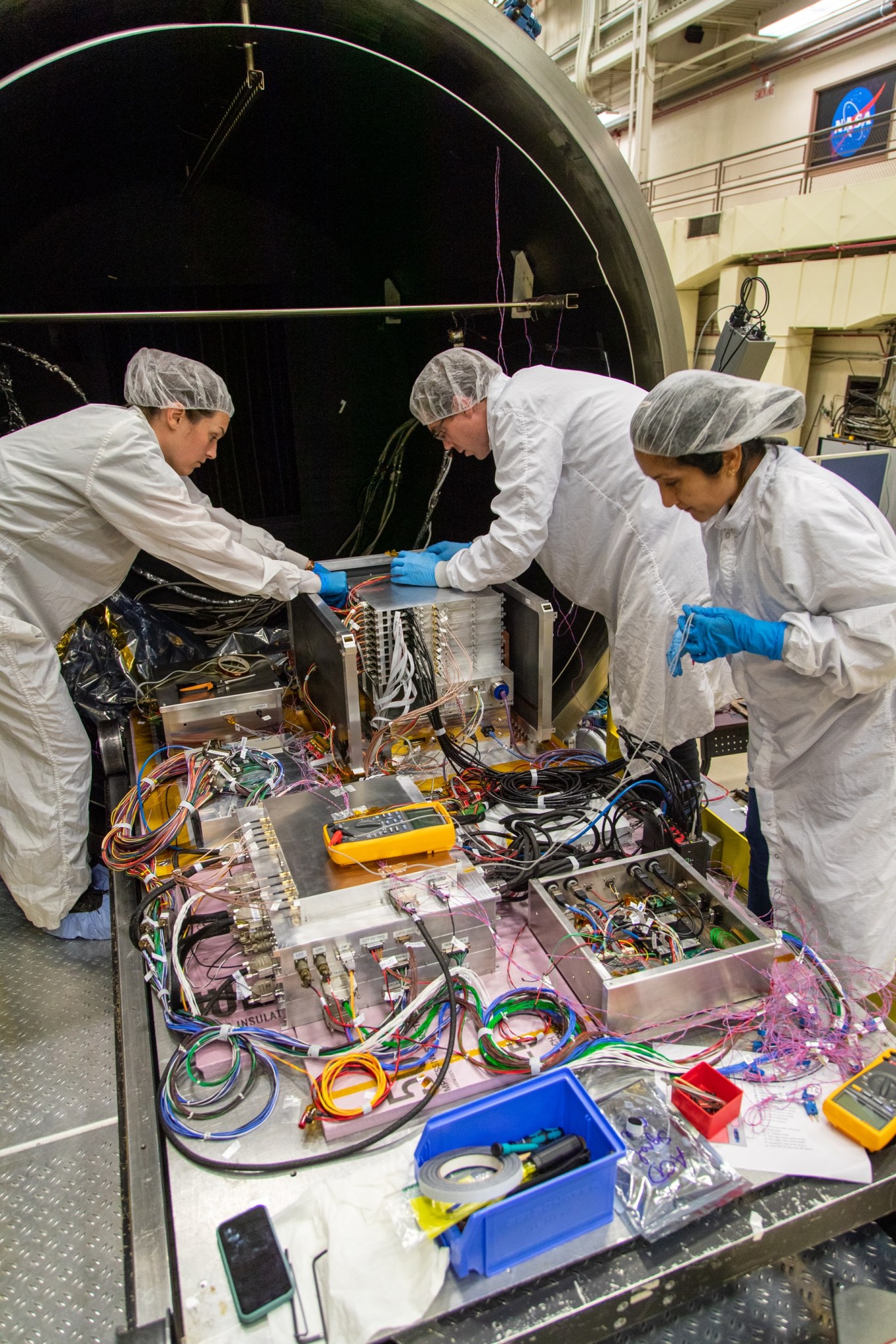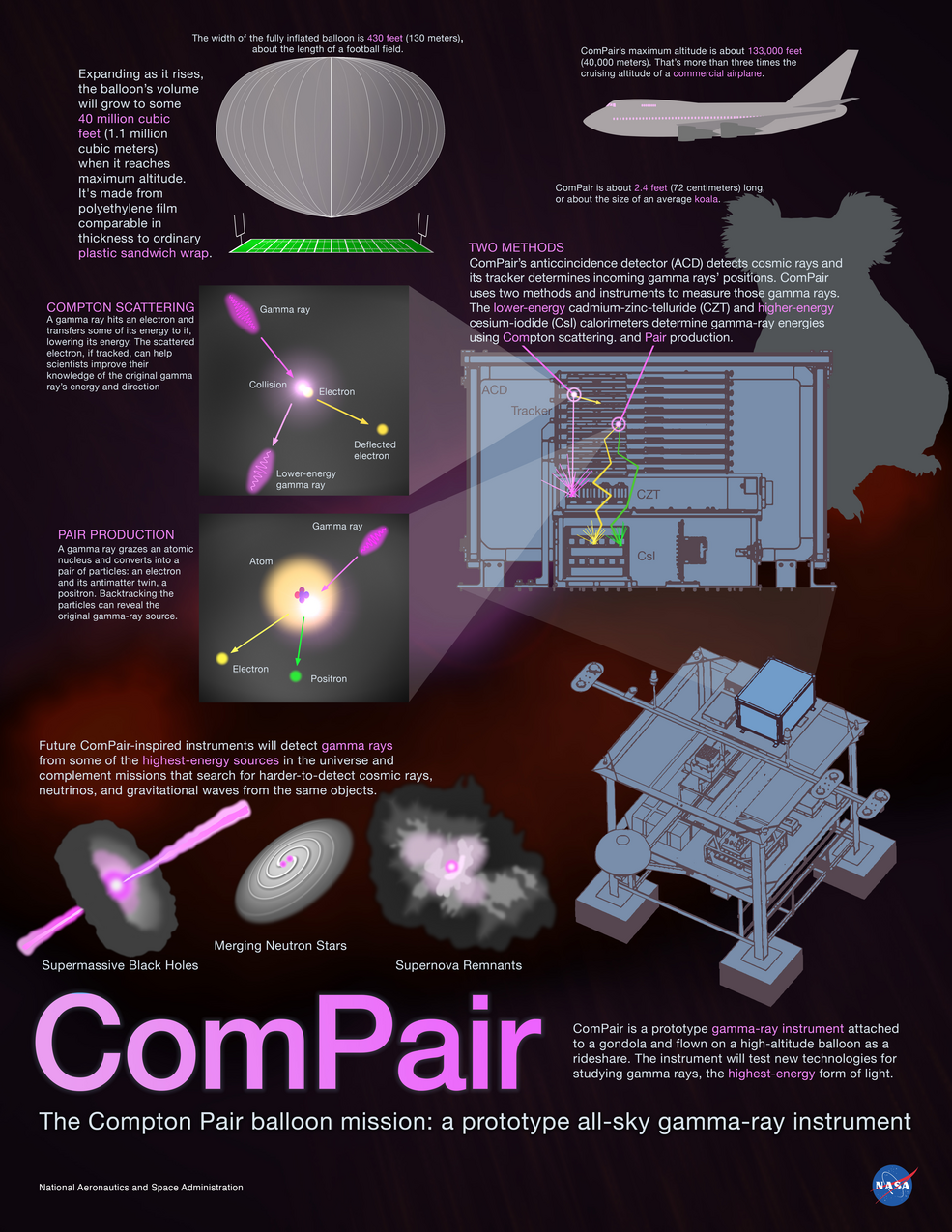A team in Fort Sumner, New Mexico, is preparing to fly a balloon-borne science instrument called ComPair, which will test new technologies for detecting gamma rays, the highest-energy form of light.
ComPair is slated to fly early in NASA’s 2023 fall scientific balloon campaign, which opens on Thursday, Aug. 10, weather permitting.
“Lots of interesting science happens in the energy range that ComPair is designed to study,” said Nicholas Kirschner, a graduate student at George Washington University in Washington and NASA’s Goddard Space Flight Center in Greenbelt, Maryland, who works on the mission. “These gamma rays are hard to capture with existing methods, so we need to create and test new ones. ComPair’s flight gets us one step closer to putting a similar detector in space.”
ComPair detects gamma rays with energies between 200,000 and 20 million electron volts. Visible light’s energy falls between 2 and 3 electron volts, for comparison.
Supernovae and powerful explosions called gamma-ray bursts shine the brightest in this energy range. It’s also where astronomers expect to see the strongest glow from the most massive and distant active galaxies, which are powered by monster black holes. Current missions don’t cover this range well, however, so future ComPair-inspired instruments could fill in important gaps in astronomers’ knowledge.
Earth’s atmosphere filters out most of the high-energy radiation coming from space – which is good for humans but makes testing new gamma-ray technologies challenging. ComPair’s solution is to fly to about 133,000 feet (40,000 meters) on a scientific balloon, which brings it above 99.5% of the atmosphere.
After building and testing ComPair at Goddard, the mission team shipped it to Fort Sumner. There, they unpacked, reassembled, and recalibrated the instrument.
ComPair will piggyback with another mission, called GRAPE (Gamma-Ray Polarimeter Experiment), led by the University of New Hampshire. After ComPair and GRAPE are on the gondola, the framework that will attach to the scientific balloon, the teams can prepare for launch.
ComPair gets its name from two methods it uses to study gamma rays: Compton scattering and pair production. In Compton scattering, light hits a particle, such as an electron, and transfers some energy to it. Pair production occurs when a gamma ray grazes the nucleus of an atom and converts into a pair of particles – an electron and its antimatter counterpart, a positron.

“Gamma rays are too high-energy for a traditional telescope to detect – the light flies right between the mirror’s atoms,” said Regina Caputo, ComPair project manager at Goddard. “Instead, our instrument uses layers of different kinds of elements and compounds stacked on top of each other. As gamma rays pass through the instrument, they interact with different layers depending on their energies.”
The instrument has four major components:
- A tracker containing 10 layers of silicon detectors that determines the position of incoming gamma rays.
- A high-resolution calorimeter made of cadmium, zinc, and telluride that precisely measures lower-energy Compton-scattered gamma rays and some converted into electron-positron pairs.
- A high-energy calorimeter made of cesium iodide that mostly measures electron-positron pairs as well as some Compton-scattered gamma rays.
- An anticoincidence detector that notes the entry of high-energy charged particles called cosmic rays.
“Cosmic rays are everywhere in the universe – large numbers collide with every part of Earth’s atmosphere every moment of every day. They also run into spacecraft, including gamma-ray missions” said Richard Woolf, a research physicist at the U.S. Naval Research Laboratory (NRL) in Washington. “Because they’re charged, cosmic rays can trip gamma-ray detectors, including future ComPair-inspired ones. So, we need anticoincidence detectors to filter them out.”
ComPair is a collaboration among Goddard, NRL, Brookhaven National Laboratory in Upton, New York, and Los Alamos National Laboratory in New Mexico.
NASA’s scientific balloons offer frequent, low-cost access to near-space to conduct scientific investigations and technology maturation in fields such as astrophysics, heliophysics, and atmospheric research, as well as training for the next generation of leaders in engineering and science. To follow the missions in the 2023 Fort Sumner fall campaign, visit NASA’s Columbia Scientific Balloon Facility (CSBF) website for real-time updates of a balloon’s altitude and GPS location during flight.
NASA’s Wallops Flight Facility in Virginia manages the agency’s scientific balloon flight program with 10 to 15 flights each year from launch sites worldwide. Peraton, which operates CSBF in Texas, provides mission planning, engineering services, and field operations for NASA’s scientific balloon program. The CSBF team has launched more than 1,700 scientific balloons over some 40 years of operations. NASA’s balloons are fabricated by Aerostar. The NASA Scientific Balloon Program is funded by the NASA Headquarters Science Mission Directorate Astrophysics Division.
Download high-resolution video and images from NASA’s Scientific Visualization Studio.
By Jeanette Kazmierczak
NASA’s Goddard Space Flight Center, Greenbelt, Md.
Media Contacts:
Claire Andreoli
NASA’s Goddard Space Flight Center, Greenbelt, Md.
Jeremy Eggers
NASA’s Wallops Flight Facility, Wallops Island, Va.



























